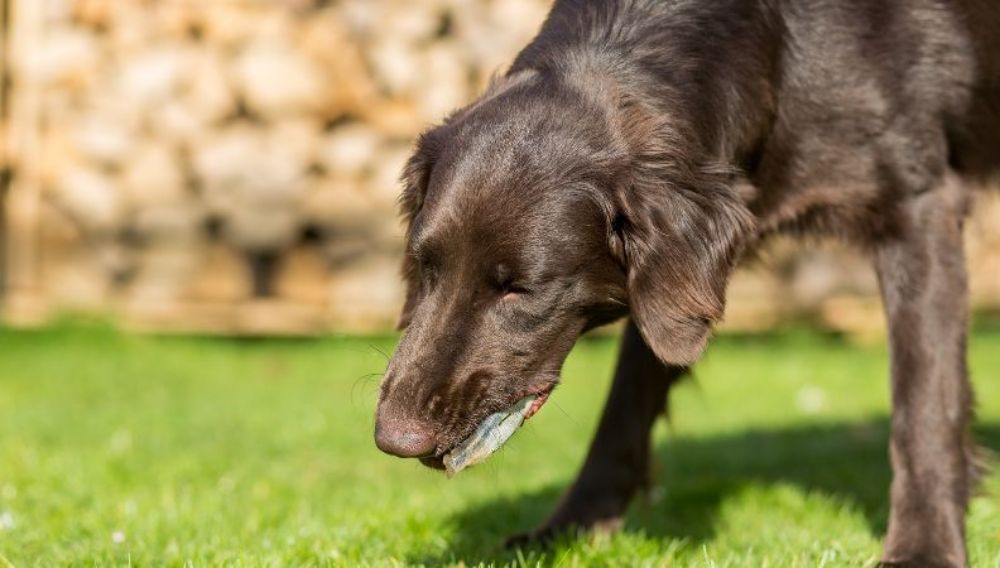
Vomiting in dogs is very common and can be caused by a range of conditions. Sometimes it can be as simple as just some regurgitated food but other times it could be a sign of something more serious. Often, your dog will get better after some chicken and rice and you'll never know the exact cause.
But for a bit of peace of mind, this is your guide to dog vomiting, with everything you need to know, from tell-tale colours, how you can treat at home and when you need to get them to the vets.
What Exactly is Vomiting?
We've all been sick before, but when your dog throws up, is that any different? Not really, vomiting is a protective mechanism to prevent toxic substances entering the body and making the dog ill. Vomiting involves contracting the tummy muscles before the contents are thrown up. You may notice your dog licking its lips, salivating lots or swallowing right before being sick.
Vomiting needs to be differentiated from regurgitation and retching (where little or no vomit is produced). Regurgitation only happens after a meal and the material will have visible lumps of undigested food in it, which are often eaten again!
Vomiting can be related to gastrointestinal or abdominal conditions (these are called primary causes) or may be linked to a systemic or neurological problem (secondary causes). The vomit may be liquid with mucous, have partially digested food in it, or be blood or bile tinged (red or yellow) – more information below on vomit colour!
What Causes Vomiting?
Dog vomiting can be caused by a stomach, intestinal, abdominal, or metabolic problem. Or may be due to a neurological condition, the side effects of drugs or a toxic substance. Dietary indiscretion is a tendency to eat things outside of their normal dog food diet. Some dogs like to scavenge or bin dive, which often leads to an upset stomach and vomiting.
If your dog tends to be sick in the morning this could be due to your dog vomiting bile which has leaked into the stomach overnight because they haven’t eaten for a while. Let your vet know if this is the case – reflux gastritis or even pregnancy might be the cause.
If the vomiting is caused by a stomach problem, your vet will consider gastritis, foreign bodies, GDV (gastric dilatation/volvulus syndrome), cancer, ulcers, intestinal parasites, bacterial and viral infections (a vomiting bug). An obstruction of the intestines, colitis, pancreatitis, peritonitis, endocrine disease, and toxins are other conditions your vet will want to rule out.
Motion sickness from a car ride may also be the cause of a vomiting dog.
Dog Vomit Colour Guide
The colour of dog vomit will help your vet with the diagnosis and treatment of your dog. Our colour guide can help you identify the cause and give you a head start getting your dog treatment.

- Green vomit is usually caused by your dog eating grass as some dogs like to do. But it could be due to bile so keep an eye out if it happens again.

- A dog vomiting yellow vomit can also be caused by bile, but to a lesser extent than if the vomit is green.

- Black vomit may just be the result of your dog eating earth! But if the vomit looks like coffee granules, then this might indicate a stomach ulcer. Black vomit can actually be a very dark red – in either case, take your dog to the vet.

- A dog vomiting blood (bright red colour) also indicates a problem that needs to be investigated.

- If the dog is vomiting white foam or it’s bright yellow, it can be an indication of a serious gastric problem that needs veterinary attention as soon as possible. White foamy vomit is more likely if your dog is sick on an empty stomach, but could also be a sign of Kennel Cough.

- Brown dog vomit (along with very bad breath) may mean your dog has eaten poo! But if it continues, it could be a sign that there is an intestinal blockage so contact your vet.
If you’re concerned about the colour of the vomit and your dog appears to be in pain, call your vet for advice as soon as possible.

Dog Vomiting Treatment at Home
Vomiting can often be managed at home just by fasting for 24 hours and then allowing small amounts of water if the vomiting has stabilised. Once your dog has stopped vomiting, a low-fat diet can be given. Don’t feed them their usual dog food until they show signs of recovery.
Always make sure your dog has access to fresh water. If they don’t appear to be in distress and aren’t losing weight, the best treatment for dog vomiting is to not feed your dog for a day, then stick to bland diets like some cooked white fish or chicken and rice, until their tummy settles.
Dog Vomiting - When to Worry!
In most cases, vomiting is short-lived, and your dog will be back to normal in no time without needing any veterinary treatment. But, if they continue feeling nauseous and vomiting continues for more than a couple of days, make an appointment with your vet, especially if they’ve also had diarrhoea.
If your dog becomes dehydrated, fluid therapy and replacement electrolytes may be given at the vet surgery. Puppies can become dehydrated more quickly than adults so may need an urgent veterinary appointment. Vomiting can also be a sign of heatstroke, in the heat of the summer months, it's really important to keep an eye on your dog. Heatstroke can be fatal, so you need to act quickly so your dog can receive urgent treatment.
To help your vet find out the exact cause of the vomiting, they’ll ask you questions like:
- What food has your dog has eaten?
- What colour is the vomit?
- Have other pets in the household been affected?
- Has your dog been hunting or scavenging?
- Have they had any medical treatment recently or been exposed to any potential poisons?
Arriving at the surgery with the answers to all these questions written down, will be a huge help to your vet. If vomiting persists (becomes chronic), your vet can prescribe anti-nausea medication to ease the sickness.
Vomiting is not a life-threatening condition, but the cause of the vomiting could be. Your vet will want to carry out some tests to find the cause. A small sample of the dog vomit may be taken and analysed for a bacterial infection or to identify any parasites in the gut. Blood tests, urine samples and X-rays may also be taken.
Endoscopic examination (looking into the stomach with a very small camera) may also be carried out – if a foreign body is discovered, it can be removed during this procedure. A small sample of tissue maybe taken for examination. If your vet does find an obstruction, surgical treatment will be recommended.
Vomiting can be very unpleasant for dogs and their owners alike! Many things can upset your dog’s stomach and the colour of the vomit can be important in finding out the cause. In most cases of vomiting, the dog shows signs of improvement within 24 hours and a full recovery in a couple of days. Make an appointment with your vet if your dog doesn’t improve within a day.
Everypaw Dog Insurance
Everypaw's Dog Insurance comes with 24/7 unlimited access to vets and vet nurses that can help with your pet's health, care, nutrition and behaviour. So you can rest assured your pup will be well looked after.
Content provided from Vetstream's Vetlexicon Canis - www.vetstream.com/treat/canis
Vetlexicon is the world’s largest peer-reviewed online clinical reference source. All our content is written and peer-reviewed by over 1,000 of the world’s leading veterinarians, ensuring relevance, accuracy and quality.
- Kyle Braund, Clive Elwood, James Simpson (online) Vomiting. In: Vetlexicon Canis. Vetstream Ltd, UK. Website: https://www.vetlexicon.com/treat/canis/diseases/vomiting
- Vetstream Ltd (online) Vomiting and diarrhea Client Information. In: Vetlexicon Canis. Vetstream Ltd, UK. Website: https://www.vetlexicon.com/treat/canis/client-information/vomiting-and-diarrhea